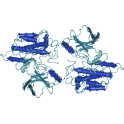
- Remove this product from my favorite's list.
- Add this product to my list of favorites.
Products
Newsletter
 |  |  |  |  |  |

Background
The Insulin-like Growth Factor 1 Receptor (IGF1R) is also known as CD221, JTK13. and is a transmembrane receptor that is activated by IGF-1 and by the related growth factor IGF-2. It belongs to the large class of tyrosine kinase receptors. This receptor mediates the effects of IGF-1, which is a polypeptide protein hormone similar in molecular structure to insulin. IGF1R is make up of two alpha subunits and two beta subunits ,the Both the α and β subunits are synthesized from a single mRNA precursor. The precursor is then glycosylated, proteolytically cleaved, and crosslinked by cysteine bonds to form a functional transmembrane αβ chain. The α chains are located extracellularly while the β subunit spans the membrane and are responsible for intracellular signal transduction upon ligand stimulation. IGF1R have a binding site for ATP, which is used to provide the phosphates for autophosphorylation. There is a 60% homology between IGF1R and the insulin receptor. In response to ligand binding, the α chains induce the tyrosine autophosphorylation of the β chains. This event triggers a cascade of intracellular signaling that, while somewhat cell type specific, often promotes cell survival and cell proliferation.
Source
Recombinant Human IGF1R /CD221 Protein (rhIGF1R), His Tag (IGR-H5229) is expressed from human 293 cells (HEK293). It contains AA Glu 31 - Asn 932 (Accession # P08069-1).
Predicted N-terminus: Glu 31
Molecular Characterization
This protein carries a polyhistidine tag at the C-terminus.
This protein contains a furin convertase cleavage site, 737-RKRR-740, and will be partially processed into N (α chain) and C-terminal fragment (partial β chain) with calculated MW of 81.0 kDa and 23.8 kDa respectively. The protein migrates as 35-45 kDa (partial β chain), 110-120 kDa (α chain) and 130 kDa (α chain & partial β chain) under reducing (R) condition (SDS-PAGE) due to glycosylation.
Endotoxin
Less than 1.0 EU per μg by the LAL method.
Purity
>90% as determined by SDS-PAGE.
>90% as determined by SEC-MALS.
Formulation
Lyophilized from 0.22 μm filtered solution in PBS, pH7.4. Normally trehalose is added as protectant before lyophilization.
Reconstitution
See Certificate of Analysis for details of reconstitution instruction and specific concentration.
Storage
For long term storage, the product should be stored at lyophilized state at -20°C or lower.
Please avoid repeated freeze-thaw cycles.
This product is stable after storage at:
-20°C to -70°C for 12 months in lyophilized state;
-70°C for 3 months under sterile conditions after reconstitution.
Bioactivity
Please refer to product data sheet.
(1) "Evaluating the effect of recombinant human growth hormone treatment on sleep-related breathing disorders in toddlers with Prader-Willi syndrome: a one-year retrospective cohort study"
Guo, Fu, Zhou et al
BMC Pediatr (2024) 24 (1), 32
(2) "Chromatographic-mass spectrometric analysis of peptidic analytes (2-10 kDa) in doping control urine samples
Thomas, Walpurgis, Thevis"
J Mass Spectrom (2024) 59 (1), e4996
(3) "Pasireotide: potential treatment option for McCune-Albright-associated acromegaly"
Ilie, Raverot, Brac de la Perrière
Eur J Endocrinol (2024) 190 (1), K17-K20
Showing 1-3 of 3749 papers.
Follow us